From the State Board
Coronavirus impact on GNPS Activities
GNPS is in full support of state- and county-directed measures to slow the spread of this virus. Planned meetings have been canceled and the rescue program will take a hiatus in April. Restoration and propagation activities may continue on a limited basis, allowing members time together outdoors while minding best practices from state healthcare professionals. When meetings can be rescheduled, we will let you know where and when they’ll be. Stay safe, friends, we want to keep all of you with us.
Looking for a Symposium Chair for 2021
For those of you who have attended our symposiums in the past 25 years, you know that it takes a lot of volunteers to deliver such a well-executed program. It also takes one special person to coordinate across the many individual efforts to ensure that it all comes together. With a well-defined symposium committee already in place and the program planning already underway, we are now seeking someone to be the overall chair for 2021. This is a unique opportunity to work with experienced GNPS members across the state to help pull together this signature annual GNPS educational event. If you are interested in this volunteer position, please contact Ellen Honeycutt at ellenhoneycutt@gnps.org.
New Focus for Stone Mountain Propagation Project (SMPP)
Members who volunteer regularly at SMPP know that we’ve been contemplating our mission and operations at SMPP to better align with the growth of GNPS as a statewide organization. We want SMPP to focus more on education and conservation support than on plant production for sale. To this end, we would like to build more raised beds around the site and shift to growing more plants in raised beds and fewer in pots. This will reduce the up-potting activities that often dominate workdays and simplify watering during summer months. Plus, we all know natives prefer growing in the ground rather than in pots, which allows volunteers to better learn growth habits of different plants.
Some other ideas being circulated are to focus our plant inventory on Piedmont native plants that are less readily available at native plant nurseries and to serve as an in-ground holding area for rescued plants awaiting permanent placement at restoration sites or other conservation areas. We envision continuing seed and vegetative propagation, depending on volunteer interest and leadership. Although Elaine Nash and Karen McCaustland will continue to serve as mentors, we are building a new activity leadership team who will shape this new direction with the guidance of the state conservation committee. Please contact loriconway@gnps.org if you’d like to join this team.
And as always, if you have questions or would like to reach us about other matters, send email to board@gnps.org.
Top photo: Painted trillium (Trillium undulatum). See the Plant Spotlight below.
Spring Plant Sale Cancelled
Ellen Honeycutt and Sheri George, co-chairs
We are very sorry to announce that we will not be holding our spring plant sale this year. After much consideration of rescheduling to a later date or hosting an online sale, we have decided that the first is unlikely given the predictions of when it will be safe to gather again. The online sale, without having the paid staff that other groups have, would be too taxing on our volunteers during this time or even prohibitive given the many stay in place orders.
We realize that this is yet another disappointment during this difficult time — especially when some of us have more time than ever to work in our landscapes! Some nurseries are still open on a limited basis and we encourage you to consider giving them your business, especially some of the smaller ones. You can find a list of nurseries on our website. This is also an excellent time to remove English ivy, privet, Japanese honeysuckle, and other invasive plants from your property.
Chapter News: Coastal Plain
Heather Brasell
Spring is a busy time of year for native plant enthusiasts — celebrating new growth and flowers in natural communities, propagating plants for plant sales and community projects, attending educational programs, and working in our own gardens. Unfortunately, for the last month we have been dealing with COVID-19. The South Georgia Native Plant and Wildflower Symposium in Tifton, Middle Georgia State University’s Spring Garden Symposium in Macon, A Day in the Woods community event in Alapaha and several other events being planned were canceled. Plant sales have also been canceled. Although this has changed a lot of what we can do in interacting with other people, it doesn’t stop us from enjoying our native plants.
GNPS Symposium, Macon
The annual GNPS symposium is always a great event to attend. It had excellent speakers, plants and plant books for sale, plant-related crafts and artwork, and tables where organizations provide interesting information. It also provides opportunities to network with other plant enthusiasts. Ever since the symposium has been held in Macon, members of the Coastal Plain Chapter, led by Amy Heidt, have volunteered for the grunt work that goes into making the symposium successful. This includes setting up the rooms, doing registration, and cleaning up afterwards. It also includes decorating tables and stage. To make the centerpieces, Amy Heidt and Paul Sumner brought blocks of pecan wood covered with resurrection fern (Polypodium polypodioides), sitting on saw palmetto (Serenoa repens) fronds. These were not only beautiful, but they were sold as a fund raiser for the chapter. Several people who bought them last year commented at how well they thrived.

Amy Heidt with pecan branches loaded with resurrection ferns; table centerpieces with resurrection fern and saw palmetto frond; one of the display boards for CPC table.
The Coastal Plain Chapter had an information table at the symposium. People starting new chapters of GNPS were interested in seeing how our chapter operates. Every chapter is different. Because the Coastal Plain is sparsely populated over a large area, we focus on a few day-long events rather than regular meetings with speakers. We also focus on conservation and community projects rather than private gardens. Several chapter members have been members of the Georgia Plant Conservation Alliance, helping with protecting, monitoring, and enhancing populations of threatened and endangered plant species in the Coastal Plain region. State Board member Amy Heidt is chairperson for the GNPS Conservation Committee. Four chapter members attended the GPCA planning meeting held in Athens, as did state Vice Chair Lori Conway.
Plant Sales
We have been propagating plants for our usual spring plant sales. Because these sales have been canceled, Amy Heidt has planned another way to get plants to people in the Tifton area who want to plant them. We will have online sales with pick up or delivery with no human contact. We will create a list of what plants are available and distribute this to the CPC members.
Community Projects
Marilynne Marshall and Mary Alice Applegate have been working on a butterfly garden for Len Lastinger Elementary School in Tifton. Five kindergarten classes got their `hands into the soil as they replanted an abandoned butterfly garden at the school. The 20’ x 30’ neglected space was part of a larger school garden area that included raised vegetable beds and a chicken coop. CPC member Marilynne Marshall led the butterfly garden project and selected a variety of natives — a redbud tree (Cercis canadensis); coral honeysuckle (Lonicera sempervirens); three shrubs: strawberry bush (Euonymus americanus), firebush (Hamelia patens) and Southern arrowwood (Viburnum dentatum); and several flower varieties including scarlet sage (Salvia coccinea), blanket flower (Gaillardia pulchella), Stokes aster (Stokesia laevis), and three Coreopsis species. More flower varieties will be added from plants Marilynne propagates from seed. This project was proposed by kindergarten teacher Jaime Judy last November after CPC members completed a native plant border garden around the school’s Outdoor STEM Learning Lab. CPC members Amy Heidt and Mary Alice Applegate assisted with garden prep, removing weeds and pre-digging holes for many plants. Marilynne Marshall’s volunteer hours will be credited to the Certificate in Native Plants program being offered at the UGA Tifton Campus this year. They have been unable to continue installing a paved stone pathway because the school is closed.
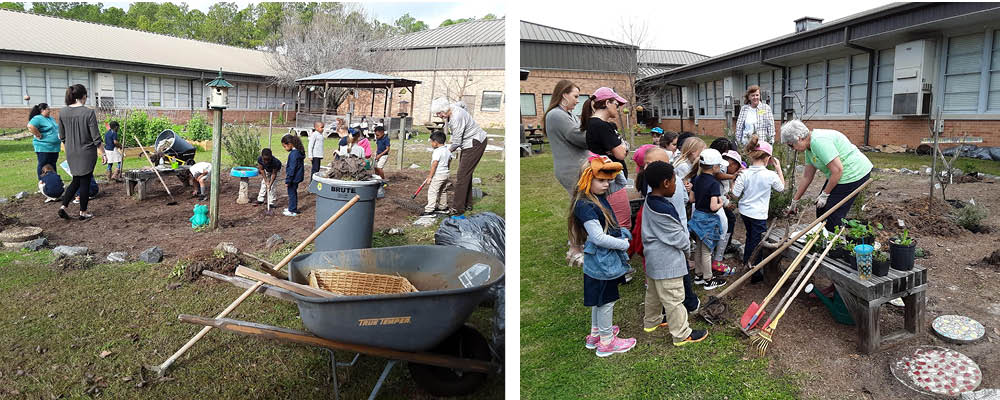
Len Lastinger Butterfly garden project.
Members have been thinking of different ways to involve parents and children home from school in learning about native plants. Karan Rawlins is providing blue mist flower (Conoclinium coelestinum) and a mint species for families at her church. She will provide guidance about planting and caring for these plants in their own gardens. She hopes the plants will be flowering by August, ready for the children to participate in the Great Georgia Pollinator Census (GGAPC). Every couple of days, Becky Griffin is providing activities for parents to do with children on the Facebook page for the GGAPC. Project Learning Tree also has activities for parents and children at their web site.
Certificate in Native Plants
The 2020 Certificate in Native Plants program is off to a good start with quite a few new people attending the courses. The courses parallel the program offered by the State Botanical Garden, but speakers, plants, and field trips come from the Coastal Plain region. We have held four courses so far. An elective Ethnobotany was taught by Ben Gahagen of Abraham Baldwin Agricultural College. One of the activities involved separating fiber from Indian hemp (Apocynum cannabinum) and making it into cordage. The core course Basic Botany was taught by Jason Scott, also from Abraham Baldwin Agricultural College. The second core course Natural Communities was taught by Katherine Melcher from the University of Georgia. Katherine used a matching activity for participants to identify characteristics of each ecoregion in Georgia, then used differences in soil moisture and fire disturbance to make sense of the 20 natural communities in the Coastal Plain. The field trip component included a haywagon ride to compare six different natural communities. Other courses have been canceled. For more information about the program or to enroll, contact Sean Cameron at 706-542-6156, cscamero@uga.edu.

Two left photos: Ethnobotany activity. Two right photos: Katherine Melcher’s course on Natural Communities.
Presentations
Members continue to make presentations to various groups such as garden clubs. Last year Amy Heidt made three presentations to garden clubs, Karan Rawlins and Eamonn Leonard made many presentations and I’m sure there were lots more that I don’t know about. More recently, Karan Rawlins has made two presentations. One was to Magnolia Garden Club. The other was an online program that will be archived for Georgia Master Gardeners.
Southern Soil
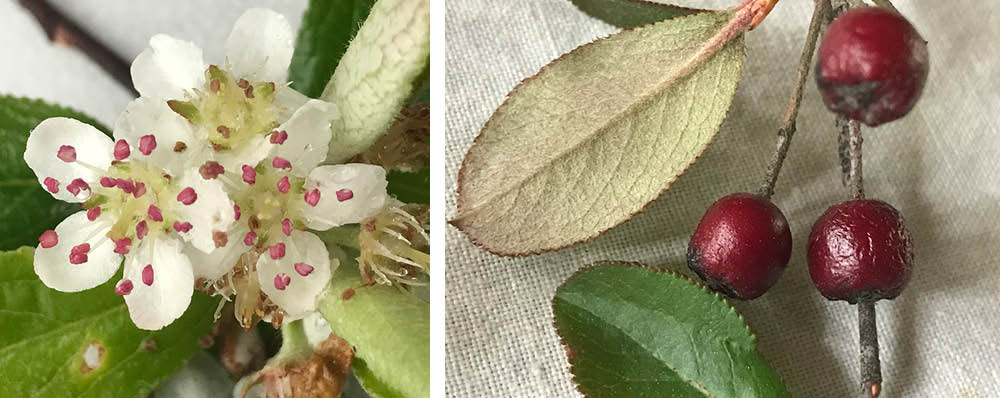
Red chokeberry flowers, fruit and leaves.
Look out for red chokeberry (Aronia arbutifolia) along roadside edges in wetland sites. In natural habitats, the shrub is fairly inconspicuous most of the year because it doesn’t have dense foliage. However, at this time of year, it is easy to detect them from the showy clusters of white flowers. One plant even had red fruit (berry-like pome) left over from last fall at the same time as new flowers and leaves.
Watch for an article about red chokeberry in the April issue of the bimonthly online journal Southern Soil (http://www.southernsoil.org/). The article is written by Karan Rawlins, who loves edible native plants. The February article on coral honeysuckle (Lonicera sempervirens) was written by Heather Brasell. Articles include a description of the plant, where it occurs in natural communities, considerations for planting in gardens, and benefits to wildlife, including humans.
Pollinator Restoration Project at Crooked River State Park
Gail Farley and Elizabeth King
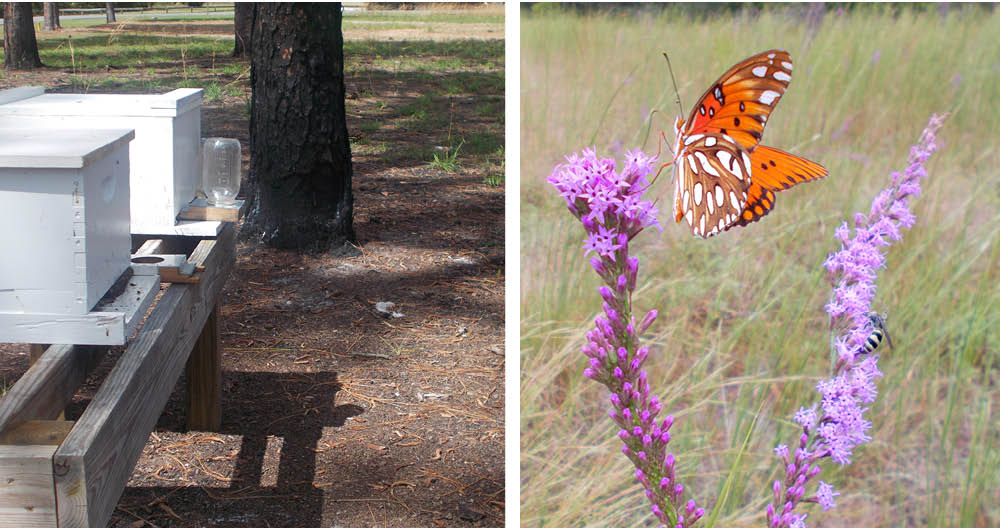
Left: Inspiration to create one-acre pollinator meadow. Right: Butterfly on purple liatris 10 months after Park stopped mowing field.
When Coastal Plain Chapter member Elizabeth King heard that honey bee hives were coming to Crooked River State Park in coastal St Marys, she suggested to Park Ranger Tracy Worsham that a one-acre mowed field be converted into a meadow of local native wildflowers and grasses. The new habitat would provide nectar, pollen, native seeds, forage and shelter to honeybees, native bees, bumblebees, wasps, flies, butterflies, birds, gopher tortoises, and other wildlife that live in the Park. Her idea was well received. Thus began a collaboration between Friends of Crooked River State Park, where both Elizabeth King and Gail Farley are members, and the Park.
The Park called it the "Pollinator Restoration Project." Friends of CRSP were given responsibility to plan and implement the project. Gail Farley volunteered to lead the effort. Step one was to stop mowing the one-acre field so that existing vegetation could grow up. By Fall 2019, little bluestem grass, Schizachyrium scoparium, had emerged as the the dominant flora. Shortleaf blazing star, Liatris tenuifolia, appeared and grew in in drifts. The best surprise was clumps of wire grass, Aristida stricta, that surfaced once mowing stopped. We collected seeds of little blue stem and Liatris. Gopher tortoise burrows and wiregrass clumps were tagged so they would not get bush hogged.
We decided to tackle just one third of the site in 2019. Once the site was bush hogged, volunteers removed as much of the existing vegetation as possible. Our goal was a cleared site that would offer best native seed to soil contact. While not ideal, we chose to have the Park use their tractor to disc and harrow the site. Our volunteers then spent many hours manually raking and removing plant debris from the sandy soil. The hills and valleys created by the tractor's work had to be smoothed to a flat soil surface. Prior to seeding, a mulched trail was created to weave its way through the site. We then seeded the bed with more than three dozen species of local ecotype native wildflowers and grasses, most being purchased from Florida Wildflowers Growers Association. We didn't have the luxury of collecting desirable seeds earlier. The bed was then rolled to press the seed into the soil. Finally, we spread a thin layer of longleaf pine straw to help keep seeds and moisture in place. With the seeds put to bed, we then walked away and hoped for the best.
We knew that many of the seeds required rain and cold temperatures to germinate. And some seeds take 2-3 years for the seed coat to wear down enough for roots to grow. The site is not irrigated, relying exclusively on natural rain. When we say "Hope it rains soon", we really mean it!

Left: Roller presses seed into soil for best contact. Most seeds need light to germinate. Right: Park Ranger broadcasts native seeds onto prepared bed.
Plant Spotlight: Trilliums, Part 2 — the Wakerobins
Ellen Honeycutt
Last month I wrote about Georgia trilliums and focused on the ones with sessile flowers: the flower sits directly on the mottled leaves. I referenced information by Tom Patrick and noted that he referred to those species as the Toadshade trilliums. This month I’ll finish up with what he called the Wakerobin trilliums. These trilliums have pedicel stalks that hold the flower away from the green leaves.
There are 12 species of trilliums in Georgia that fall into this group and Tom divided them into 3 smaller groups: the erectum group of species; species whose white flowers age to pink; and one trillium that doesn’t fall into either group. I find his groupings useful and will use them here as well.
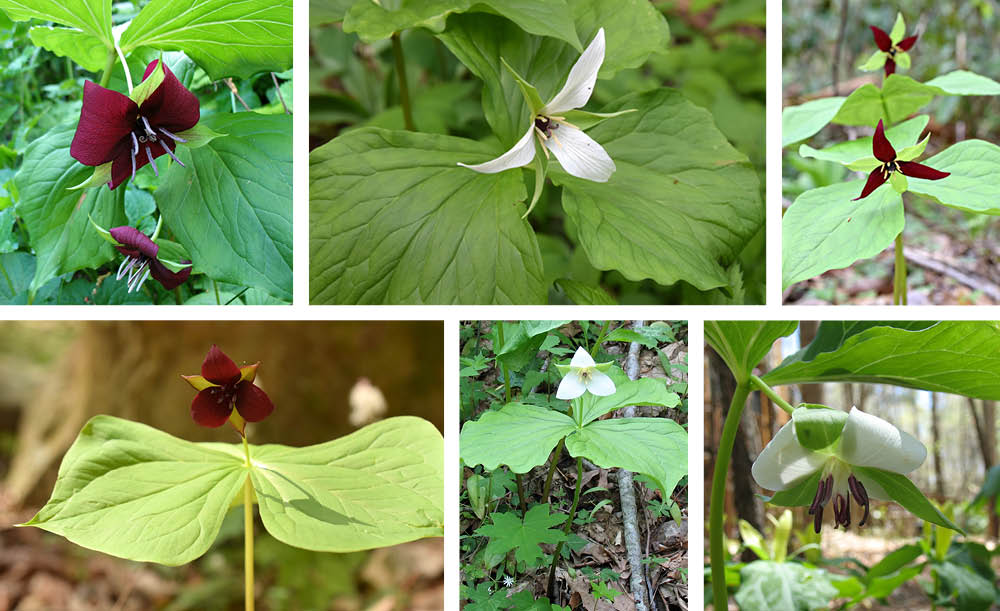
Some representatives of the erectum group of species, clockwise from top left: Trillum vaseyi, T. simile, T. erectum, T. rugelii, T. flexipes, and T. sulcatum.
The erectum complex is a group of trilliums whose flowers are held above or below the leaves but whose petals do not change colors over time. The species in this group include: Trillium erectum, T. flexipes, T. rugelii, T. simile, T. sulcatum, T. vaseyi, and an as-yet-unnamed species called Amicalola trillium.
Trillium erectum is found in far north Georgia and it is the species from which at least 3 of the others used to be associated. The petal color is red with occasional white individuals; the flower is held above the leaves. The ovary (in the center of the flower) is noticeably dark for this and several other species. Several common names reflect the unpleasant smell of the flower: stinking Benjamin, stinking Willie.
Trillium flexipes used to be considered a white form of T. erectum. The petals are creamy white and the flower is held above. One common name is bent trillium. A good place to see this one is at The Pocket at Pigeon Mountain; it is noted as only being found in Walker County.
Trillium simile is known as sweet white trillium or confusing trillium. It occasionally may have reddish petals, but it is usually white. You can distinguish it from bent trillium in Georgia by the location it is found as well as the color of the ovary (this one has a dark ovary while bent trillium has a pinkish one). Its fragrance is compared to green apples (a good way to distinguish it from T. erectum).
Trillium sulcatum was also once considered a variety of erectum. Like T. simile and T. erectum, it has a dark ovary. The petal color can vary on this one as well – from maroon to white and in-between; the flower is above the leaves. I have seen this one at Cloudland Canyon State Park.
Amicalola trillium is a late-blooming species with creamy-white petals and a pinkish ovary (which helps to distinguish it from erectum, simile, and sulcatum). The flower may be held above the leaves or just below.
Trillium rugelii is known as Southern nodding trillium because the cream-colored flowers hang down below the leaves, a trait that it shares with Catesby’s trillium—however, this species is generally much larger than Catesby’s trillium and the petals do not turn pink with age.
Trillium vaseyi is a large, late-flowering trillium with maroon flowers. It was once considered a variety of erectum. Unlike erectum, however, the flower hangs below the leaves. Its range extends beyond North Georgia, with a few counties in the upper Coastal Plain reporting its presence in USDA.
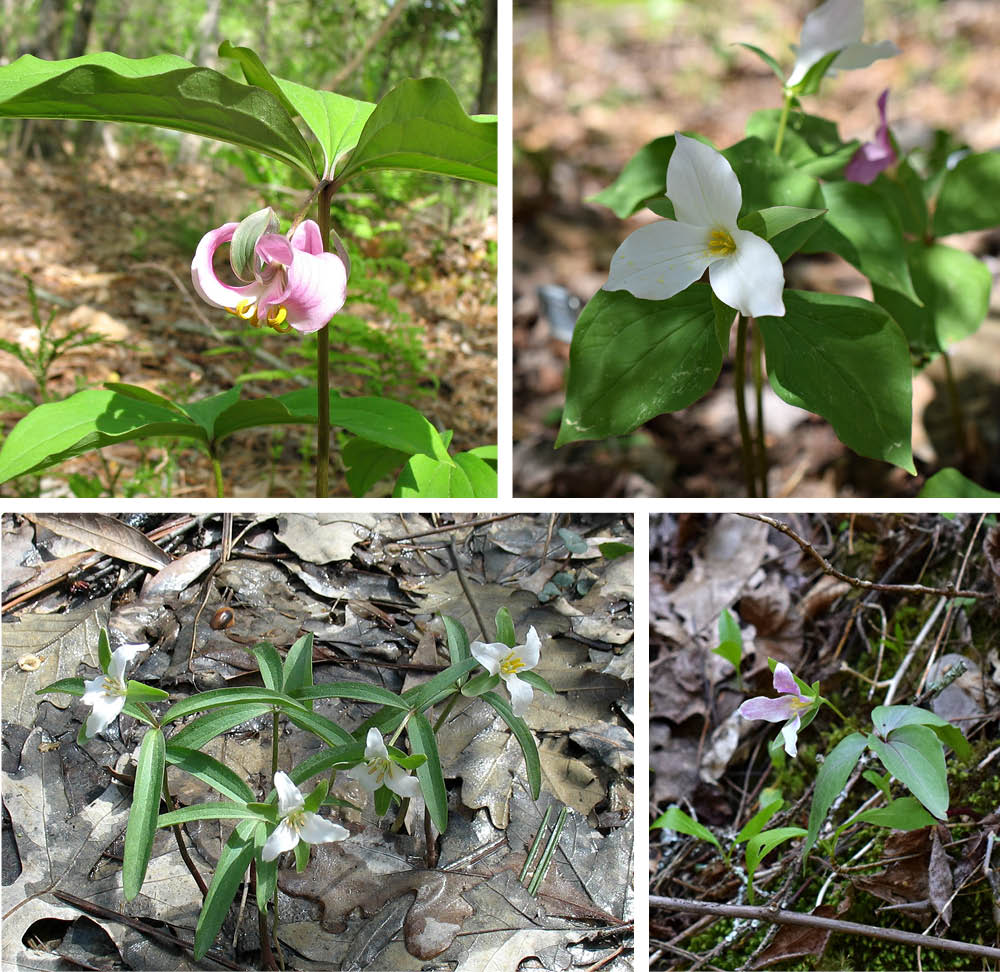
The second group of trilliums includes (clockwise from top left); Trillium catesbaei, T. grandiflorum, T. persistens, and T. georgianum.
Four species make up the group of trilliums whose white flowers turn pink with age: Trillium catesbaei, T. grandiflorum, T. persistens, and T. georgianum.
Trillium catesbaei is identified by its low hanging flower, a trait not shared by any other in this group. As I mentioned earlier, it is similar to the Southern nodding trillium until its flowers turn a gorgeous pink. This is our most widespread of the white-to-pink trilliums; it is found from the northernmost counties down into the lower Coastal Plain.
Trillium grandiflorum is one of the showiest of our white trilliums, but it has only a very northern presence in Georgia. Seeing large sweeps of it on hillsides—such as in the Smoky Mountains—is a very spectacular sight.
Trillium persistens, often called Edna’s trillium, is a smaller, early blooming trillium with a limited range that is near the Tallulah Gorge area.
Trillium georgianum (formerly Trillium pusillum var. georgianum) is also quite small and quite limited in range (only one county in Georgia). Common names include dwarf trillium and least trillium. The range of the pusillum group of trilliums across the southeast is described here if you’re interested.
The last of the species to describe for Georgia is a lovely one. Painted trillium (Trillium undulatum) can have bluish-green leaves and a spectacular flower like no other. Wavy, white petals are usually splotched with red markings, as if they were painted. The range is very northern Georgia, about 4 counties and mostly the eastern ones.
Keep a look out for some of these special Georgia flowers this spring. Finding one is always a special occasion. Our abundance of trillium species is part of what makes Georgia special, too.
Membership and Chapter Update
Michele Buchanan — Chair, Membership/Chapter Relations Committee
It's an exciting time to be a member of GNPS! It's finally spring, and the ephemerals are showing their lovely faces. Buds and blooms and lots of pollen announce the arrival of the season, and we couldn't be more delighted. The Covid-19 virus has all of us social distancing and staying at home. Still, if there is a silver lining to this cloud, it is that we have more time to spend in our gardens and at our favorite parks and natural areas.
New growth this spring isn't limited to just plants, GNPS is growing too! Changes in the organization were launched in January with a new statewide board and the initiative to add many new regional chapters. Members in several areas across the state have taken up the cause and have organized and led chapter interest meetings. Meetings have been held in Macon, Augusta/Central Savannah River Area, north metro Atlanta, and Intown Atlanta. These meetings have drawn crowds of up to 60 people! Enthusiastic members and future members have attended and been excited to learn about a new chapter forming near them.
Regional chapters are the future of GNPS. It is through chapters that members will be able to experience educational programs, field trips, workshops, plant sales, working on restoration sites, and plant rescues. When you join a chapter, part of your membership fee is paid to the chapter to give them the funding they need to host these events. However, joining a chapter never limits your options. You are part of the statewide GNPS family and may attend as many meetings and events at any chapter you wish across the state. In fact, we encourage you to do so!
Currently, GNPS has three existing regional chapters. The existing chapters are the West Georgia Chapter, the Coastal Plain Chapter, and the Redbud Chapter. Soon to join them are four forming chapters in north metro Atlanta, Intown Atlanta, the Macon area, and Augusta/Central Savannah River Area.
If you are interested in being part one of the forming chapters, the contact email for each is listed below.
If you are interested in joining one of our existing chapters, you may do so by updating your profile on the GNPS webpage. Simply go to GNPS.org, scroll down the page and click on Membership, then click on Online (immediate) membership form, then on the right-hand side of the page, click on What would you like to do? and select Join a GNPS Regional Chapter. Scroll down the page until you see a map that provides you with a general idea of the areas served by each regional chapter. Just below the map, you will see the question Would you like to participate in a regional chapter? Click on the down arrow and select the chapter you would like to join. Finally, click on Submit! That's all there is to it! If you have any problem at all doing this, please contact membership@gnps.org, and we will provide assistance.
If you are interested in starting a new regional chapter in your area and your area is not covered by any of the forming or existing chapters listed above, send an email to membership@gnps.org to let us know. We have developed a chapter quick start guide to make creating a new chapter easier than ever!
We on the board of GNPS are here to serve you. If you have any questions or want to reach out to us, you may contact us at board@gnps.org. Happy Spring!
|